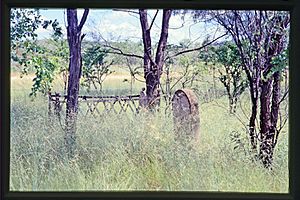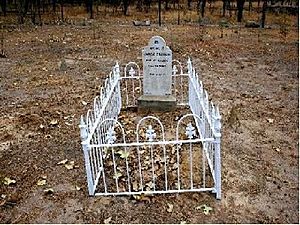Tabletop Cemetery facts for kids
Quick facts for kids Tabletop Cemetery |
|
|---|---|

Tabletop Cemetery, 2000
|
|
| Location | 15km NE of Croydon, Shire of Croydon, Queensland, Australia |
| Design period | 1870s - 1890s (late 19th century) |
| Built | c. 1887 - 1910s |
| Official name: Tabletop Cemetery | |
| Type | state heritage (built) |
| Designated | 13 April 2006 |
| Reference no. | 602371 |
| Significant period | c. 1887-1910s (fabric, and historical period of use) |
| Significant components | grave marker, fence/wall - perimeter, headstone, burial/grave, grave surrounds/railings |
| Lua error in Module:Location_map at line 420: attempt to index field 'wikibase' (a nil value). | |
The Tabletop Cemetery is a special old cemetery located about 15 kilometres (9.3 mi) northeast of Croydon in Queensland, Australia. It was built around 1887 and used until the 1910s. This cemetery is important because it's listed on the Queensland Heritage Register, which means it's protected for its historical value.
Contents
A Glimpse into History
The Tabletop Cemetery is one of six cemeteries that served the Croydon area when gold was discovered there in 1886. It's found near where the old town of Tabletop used to be, about 19 kilometres (12 mi) northeast of Croydon. The cemetery covers an area of about 1260 square metres. Experts have found 23 possible burial sites here, and one of them might even be for a Chinese person.
The Gold Rush Era
The Croydon goldfield was one of the last big gold rushes in northern Queensland during the 1800s. Gold mining was at its busiest around 1900, but then it slowed down over the next 20 years. There was a small comeback in the 1930s and again from 1988 to 1991. Today, only about 300 people live in the area.
Croydon is in the middle of the Gulf Savannah region. It's about 562 kilometres (349 mi) west of Cairns. Explorers first came to this area in the 1860s. An overland telegraph line was built through the Croydon district between 1869 and 1872. This line later became very important for the mining towns in the north.
Gold was first found on Croydon Downs Station in 1881. In 1885, Richard and Walter Alldridge found 20 places where gold could be mined. The news spread quickly, and the Croydon area was officially declared a goldfield on January 18, 1886.
Life in a Gold Town
Hundreds of people rushed to the area. By 1887, about 7,000 people lived in the district. Even by 1897, it was the third largest town in north Queensland. From 1890 to 1910, Croydon produced the second most gold in Queensland, after Charters Towers. But by 1909, gold production started to drop, and by 1914, the population had halved.
Life was tough for people on the Croydon Goldfield. There wasn't enough water, grass for animals, or wood for building and fuel. Being so far away from other towns was also a big problem until the railway to Normanton was finished in 1891. The area also faced droughts, floods, and even a cyclone in 1906. Despite these challenges, the 1890s were good years for Croydon. The town had many businesses, like banks, bakeries, hotels, and shops.
Other mining towns grew up around Croydon, such as Golden Gate, Tabletop, and Golden Valley. Croydon was the main centre for business and government. People from the smaller towns would visit Croydon on Saturday nights to shop and meet friends.
The Chinese Community
Like many other goldfields in Queensland, Croydon had a Chinese community. By the end of 1888, about 300 people in Croydon were Chinese, Cingalese, Malay, or African. Even though there were rules that made it hard for Chinese people to work on new goldfields, many worked in services like gardening, carrying goods, baking, and cooking. Sometimes there were disagreements between different groups, but people from various backgrounds lived and worked together.
In Tabletop, a baker named Jim Sing ran his business for over eight years until 1900. It's interesting that a person who was likely of Chinese background is buried among Europeans in the Tabletop cemetery. This shows how different people lived side-by-side in these mining towns.
Tabletop Town
The town of Tabletop, about 19 kilometres (12 mi) northeast of Croydon, was planned in 1887. It was one of the first areas on the Croydon Goldfield to be developed. A horse-drawn coach service soon connected Tabletop and Croydon every day.
Many mines were near Tabletop, including the Federation, Day Dawn, and Happy Jack. Two large mills helped process the gold. In 1888, a small school opened in Tabletop. This was the first school on the goldfield. By 1889, 20 children attended the school, showing that families lived there.
Tabletop quickly grew into a small service town. It had 8 hotels, a post office, 5 stores, and even a police station. About 500 miners and their families lived there, hoping to find gold. However, the town's population quickly dropped to around 220 and kept falling after the mid-1890s. Businesses started closing from 1893, and by 1920, only the Tabletop Hotel was left.
The people of Tabletop often socialized with nearby towns like Golden Valley. Horse races were very popular. The community also had support from church leaders who visited from Croydon and Golden Valley. Police officers helped keep law and order. Their presence in the town is even shown in the Tabletop cemetery.
Children's Graves
In 1893, Henry Hasenkamp, a police officer, moved to Tabletop with his wife Mary and their family. Sadly, their ten-year-old son, Henry Adolphous, died on October 19, 1893, just before his eleventh birthday. He was buried in the Tabletop cemetery. His parents put up a simple headstone and surrounded his grave with an iron fence. They even decorated the grave mound with small clam shells.
Families in mining towns often moved around a lot. Many children died young because of the tough living conditions and lack of doctors or medicines. So, it's common to find graves of individual children in these remote cemeteries. They are sad reminders of how hard life was in these early mining towns.
What the Cemetery Looks Like
Tabletop Cemetery is located at the corner of two station roads. The ground is slightly hilly and has sandy soil. Eucalyptus trees and other native plants grow around the area. Even though cattle graze nearby, a fence protects the cemetery. Native birds and animals also use this peaceful spot.
Experts have found 23 possible burial sites in the cemetery. Only five of these have headstones, and only three are surrounded by iron fences. The three graves with iron fences have been painted white recently. The graves that have been identified date from 1889 to 1904.
Some possible burial sites are marked by piles of stones, small mounds, or shallow dips in the ground. While we can't be 100% sure these are graves, similar features aren't found outside the cemetery.
All the headstones inside the fenced cemetery face east, and all the individual graves (including the stone piles and mounds) are lined up in an east-west direction.
- Grave 1: This is the grave of James Crameri, who died on November 14, 1904. It has a marble headstone with writing on it and is surrounded by a white iron fence.
- Grave 2: This is for Henry Aldolphous Hasenkamp, who died on October 19, 1893. He was almost 11 years old. Like Grave 1, it has a marble headstone and a white iron fence. It's also marked by many clam and other sea shells.
- Grave 3: This grave has an iron fence with a diagonal pattern. It has a sandstone headstone, but you can't read the writing anymore. A tree has grown through the fence at the headstone end.
- Grave 4: This is the grave of Catherine Lahy, a child who died on June 10, 1889, at age 2. It has a solid sandstone headstone with a cross carved on top and an earth mound.
- Grave 5: This is for Robert Fitzmaurice, a child who died on April 29, 1889, at age 4 years and 8 months. It has a simple stone headstone with a large cross carved into it.
- Grave 6: This grave has a solid rectangular stone headstone that looks like a Chinese grave marker, similar to others in the Croydon town cemetery. However, there's no writing on it, so we can't be sure of the person's background.
Why This Cemetery is Important
Tabletop Cemetery was added to the Queensland Heritage Register on April 13, 2006. This means it's considered very important for several reasons:
Showing Queensland's History
The cemetery, dating from around 1887, helps us understand how small mining towns like Tabletop grew and changed. It was used before any official cemetery was set up and served the town from the mid-1880s until the town faded away in the 1910s. The cemetery is a key record of the area's history. The graves, including those of two children and a person who might have been Chinese, show us about the different people who lived there, their jobs, and their social standing. It also highlights how difficult life was on the Croydon goldfields in the late 1800s and early 1900s, especially the sad fact that many babies and children died young.
Learning from the Past
Tabletop Cemetery is one of six cemeteries on the old Croydon goldfield, and it still clearly looks like an old burial ground. With 23 possible burial sites and 6 graves that still have headstones or markers (one looking like a Chinese grave marker), it has a lot to teach us. At least three graves still have their iron fences. By studying the graves, their locations, what's written on them, and the materials used, we can learn more about the early people who lived here. This includes understanding their backgrounds, social lives, and beliefs.
Connecting with the Community
Tabletop Cemetery is also important to the Croydon community. It has a special meaning for them because it connects them to the past and the people who lived there long ago.


